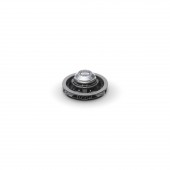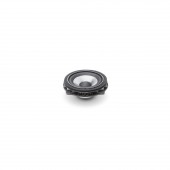Speakers for BMW Rockford Fosgate POWER T3-BMW1
Ø 100 mm, 50/100 W, 4 Ω, 90 dB (2.83V/1m), mounting depth 29.1 mm, special speakers for BMW cars
More about the product
More about the product
Speakers for BMW Rockford Fosgate POWER T3-BMW1
The T3-BMW1 is a full-range speaker system designed to replace the factory speakers installed in a BMW vehicle. The kit consists of a 1" silk tweeter with a neodymium motor and a woofer with a fiberglass diaphragm. The whole system also features a passive crossover and a factory BMW connector for easy "plug and play" installation. Made in Germany.
Key Features of Rockford Fosgate POWER T3-BMW1 Speakers
- To replace the factory version Style-2.
- 4" two-way component system.
- Fiberglass sandwich membrane with Nomex honeycomb core.
- Polyurethane canopy.
- SBR gasket and Bimax center.
- Polycarbonate basket reinforced with fiberglass.
- Ring-shaped neodymium magnet.
- 25mm high temperature oscillating metal coil.
- Tweeter: silk membrane and gasket.
- Tweeter: 25 mm voice coil.
- Tweeter: neodymium motorcycle structure.
- Tweeter: polyamide basket reinforced with fiberglass.
- Direct connection to the BMW wiring harness.
- In-line external crossover.
Rockford Fosgate POWER T3-BMW1 fits:
BMW 1 Series (2011 -> 2019)- 3-Door (F21) front door
- 5-Door (F20) front door
BMW Series 3 and 4 ( 2012 -> 2019)
- Coupe (F32) front door and rear side
- Sedan (F30) front and rear doors
- Touring (F31) front and rear doors
BMW 6 Series (2011 - 2019)
- Coupe (F13) front door
- Convertible (F12) front door
BMW X3 series (2010 - 2017)
- SUV (F25) front and rear doors
| Catalog number | T3-BMW1 |
| Brand | Rockford Fosgate |
| Links | Official web presentation |
| Speaker typeCoaxial speakers: Coaxial speakers are characterized by a so-called all-in-one design. The tweeter and mid-bass speaker are in one basket. The advantage is simpler assembly, but thanks to the connection or proximity of the bands in one speaker, the sound quality will usually be reduced. As a rule, in the middle of the mid-bass speaker, there is a tweeter whose voice coil works in the second air gap of the common magnetic circuit. The three-way coaxial speaker consists of a mid-bass speaker, a center speaker and a separate tweeter in the front on a special beam. Component Speakers: Component speakers are characterized by a division into individual frequency bands, treble + mid-bass + or. bass band. The individual speakers can be placed completely separately, which results in a better sound and acoustic performance. In the vast majority of cases of component speakers, an external crossover is also supplied, which divides the treble, middle / mid-bass, and into the three-band the bass band or allows setting the decibel level of the tweeter (e.g. +2 dB, 0 dB, -2 dB), steepness (e.g. 6dB/Oct. 12dB/Oct.) or active or bi-amp connection. | Komponentní 2 pásmové |
| RMS powerRMS speaker power is the constant power of the entire system, not just one speaker or one side. This is also the performance of continuous use of the speakers. If the RMS power is exceeded for a long time, the speakers may be irreversibly damaged! | 50 W |
| Max. (maximum performancePeak performance , which the speaker can play for a moment (approx. 0.5 s), for example when hitting drums in a song. If the max power is exceeded, the speakers will usually be damaged! | 100 W |
| Sensitivity (SPL 1W/1m)Sensitivity, sensitivity or efficiency of the speaker. Speaker sensitivity is given in decibels (dB) and simply put, the higher the value, the lower the demands on the amplifier's power. This is a defacto rating of how a speaker converts watts to sound. Sensitivity ratings are in noise level measured at 1 meter from the speaker using 1 W (watt of power) or using 2.83 volts at the source at 1 meter. A higher decibel level means the speaker is louder with less power. For every 3 dB increase in sensitivity, the speaker requires half the power to reproduce the same volume. For example, if an 88 dB speaker needs 100 Watts to produce a certain volume, then a speaker with a sensitivity of 91 dB needs only 50 Watts to reach the same volume. | 87 dB |
| ImpedanceImpedance - measurement of electrical resistance. When buying speakers, it is important to make sure that the impedance matches the amplifier or car stereo you are using. Example: A 2 Ohm speaker cannot be connected to an amplifier that is only stable up to 4 Ohms! A 4 Ohm speaker can easily be used with an amplifier that is stable up to 2 Ohms. The most common speaker impedance today is 3 - 4 Ohm. | 4 Ω |
| Frequency rangeThe ability of the speakers to play a signal from the lowest frequency to the highest, or the speaker's ability to faithfully reproduce sound in a specific frequency band. Professionally: In the frequency range from 40 to 16,000 Hz, the vast majority of fundamental and overtones (harmonics) of all musical instruments are found. We are interested in the course of the radiated sound pressure in this range of frequencies when the loudspeaker system is supplied with constant power. We call this course the frequency characteristic, which tells us the level of radiated sound pressure in decibels (dB) depending on the frequency. The frequency characteristic of a speaker or speaker system can be expressed most succinctly with a graph. Mostly, however, the frequency characteristic is indicated by indicating the maximum tolerance of the sound pressure in the given frequency range, e.g. 50 to 15,000 Hz -+ 6 dB. Since the frequency characteristics of loudspeakers and systems in general are quite uneven, some manufacturers do not even specify this maximum tolerance of sound pressure in decibels in their catalogs for reasons of prestige. Data impoverished in this way is unfortunately worthless. What is valid is that the manufacturer offers a speaker system with a frequency range of 30 to 20,000 Hz, if he is worried about stating the maximum unevenness of the sound pressure in this range, because he can have a tolerance of, for example, +- 20 dB. The unevenness or undulation of the frequency curve in good speaker systems for high-quality music performance should not exceed +-3 dB in the 80 to 12,000 Hz band and +-6 dB in the 40 to 16,000 Hz band. Greater unevenness already depletes or emphasizes certain tonal areas, which can cause audible or even disturbing distortion. The proportion between fundamental tones and higher harmonics also changes, thereby changing the color of the sound, and individual musical instruments as well as the entire musical image sound unnatural. | 75 - 20 000 Hz |
| Mid-woofer diaphragm materialThe material that was used for the speaker diaphragm. Don't be afraid of the paper, it surprisingly has a very natural and high-quality sound and, thanks to the surface treatment, it can withstand moisture without any problems. | Ze skelných vláken |
| Center speaker diameterThe diameter of the center speaker is given as the diameter of a round speaker, not including the mount, where the mounts protrude even more on smaller speakers. | 100 mm |
| Mounting depth of the center speakerThe mounting depth of the center speaker is measured from the bottom edge of the magnet to the bottom edge of the tin, plastic or cast speaker basket. | 29,10 mm |
| Tweeter dome diameterThe net diameter of the dome (diaphragm) of the tweeter. | 25 mm |
| The overall depth of the tweeterThe total depth of the tweeter itself without the installation houses. | 9,5 mm |
| Frequency crossover included in the packageThe crossover is an important part of defacto all loudspeakers. A crossover usually contains different resistor values, coil sizes, and capacitor types that fundamentally modify the sound. We describe below what the turnouts are for. Component Speakers: A crossover is part of every quality component speaker system. Its task is to ensure the distribution of frequencies that the amplifier produces in the entire acoustic spectrum of frequencies so that each of the speakers receives only that part of the band that it can optimally play in terms of efficiency and minimal distortion. Coaxial speakers: In most cases, coaxial loudspeakers have a simple crossover (6dB/Oct.) formed by a capacitor at the tweeter. | Ano |
| Cover grids included in the packageOriginal cover grilles in speaker packaging. | Ne |
| Price forIf the price is for a pair, the package always includes 2 pieces of everything, e.g. 2x mid-bass, 2x tweeter and 2x crossover. | Pár |
Product comments
Evaluation
- Car speakers Speakers by car brand Speakers for BMW Speakers for BMW 1 (F20, F21)
- Car speakers Speakers by car brand Speakers for BMW Speakers for BMW 3 (F30, F31, F34)
- Car speakers Speakers by car brand Speakers for BMW Speakers for BMW 4 (F32, F33, F82, F83)
- Car speakers Speakers by car brand Speakers for BMW Speakers for BMW 6 (F12, F13)
- Car speakers Speakers by car brand Speakers for BMW Speakers for BMW X3 (F25)
- Car speakers 100 mm car speakers Component speakers 100 mm
- Promotional goods and sales Car speakers on sale
- ROCKFORD FOSGATE speakers, subwoofers and amplifiers
ask us


